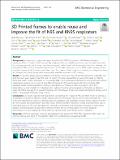| dc.contributor.author | McAvoy, Malia | |
| dc.contributor.author | Bui, Ai-Tram N. | |
| dc.contributor.author | Hansen, Christopher | |
| dc.contributor.author | Plana, Deborah | |
| dc.contributor.author | Said, Jordan T. | |
| dc.contributor.author | Yu, Zizi | |
| dc.contributor.author | Yang, Helen | |
| dc.contributor.author | Freake, Jacob | |
| dc.contributor.author | Van, Christopher | |
| dc.contributor.author | Krikorian, David | |
| dc.contributor.author | Cramer, Avilash | |
| dc.contributor.author | Smith, Leanne | |
| dc.contributor.author | Jiang, Liwei | |
| dc.contributor.author | Lee, Karen J. | |
| dc.contributor.author | Li, Sara J. | |
| dc.contributor.author | Beller, Brandon | |
| dc.contributor.author | Huggins, Kimberley | |
| dc.contributor.author | Short, Michael Philip | |
| dc.contributor.author | Yu, Sherry H. | |
| dc.contributor.author | Mostaghimi, Arash | |
| dc.contributor.author | Sorger, Peter K. | |
| dc.contributor.author | LeBoeuf, Nicole R. | |
| dc.date.accessioned | 2021-06-14T19:27:36Z | |
| dc.date.available | 2021-06-14T19:27:36Z | |
| dc.date.issued | 2021-06 | |
| dc.date.submitted | 2020-07 | |
| dc.identifier.issn | 2524-4426 | |
| dc.identifier.uri | https://hdl.handle.net/1721.1/130941 | |
| dc.description.abstract | Background: In response to supply shortages caused by the COVID-19 pandemic, N95 filtering facepiece respirators (FFRs or “masks”), which are typically single-use devices in healthcare settings, are routinely being used for prolonged periods and in some cases decontaminated under “reuse” and “extended use” policies. However, the reusability of N95 masks is limited by degradation of fit. Possible substitutes, such as KN95 masks meeting Chinese standards, frequently fail fit testing even when new. The purpose of this study was to develop an inexpensive frame for damaged and poorly fitting masks using readily available materials and 3D printing.
Results:An iterative design process yielded a mask frame consisting of two 3D printed side pieces, malleable wire links that users press against their face, and cut lengths of elastic material that go around the head to hold the frame and mask in place. Volunteers (n = 45; average BMI = 25.4), underwent qualitative fit testing with and without mask frames wearing one or more of four different brands of FFRs conforming to US N95 or Chinese KN95 standards. Masks passed qualitative fit testing in the absence of a frame at rates varying from 48 to 94 % (depending on mask model). For individuals who underwent testing using respirators with broken or defective straps, 80–100 % (average 85 %) passed fit testing with mask frames. Among individuals who failed fit testing with a KN95, ~ 50 % passed testing by using a frame.
Conclusions: Our study suggests that mask frames can prolong the lifespan of N95 and KN95 masks by serving as a substitute for broken or defective bands without adversely affecting fit. Use of frames made it possible for ~ 73 % of the test population to achieve a good fit based on qualitative and quantitative testing criteria, approaching the 85–90 % success rate observed for intact N95 masks. Frames therefore represent a simple and inexpensive way of expanding access to PPE and extending their useful life. For clinicians and institutions interested in mask frames, designs and specifications are provided without restriction for use or modification. To ensure adequate performance in clinical settings, fit testing with user-specific masks and PanFab frames is required. | en_US |
| dc.publisher | Springer Science and Business Media LLC | en_US |
| dc.relation.isversionof | https://doi.org/10.1186/s42490-021-00055-7 | en_US |
| dc.rights | Creative Commons Attribution 4.0 International license | en_US |
| dc.rights.uri | https://creativecommons.org/licenses/by/4.0/ | en_US |
| dc.source | BMC | en_US |
| dc.title | 3D Printed frames to enable reuse and improve the fit of N95 and KN95 respirators | en_US |
| dc.type | Article | en_US |
| dc.identifier.citation | McAvoy, Malia et al. "3D Printed frames to enable reuse and improve the fit of N95 and KN95 respirators." BMC Biomedical Engineering 3, 1 (June 2021): 10. © 2021 The Author(s) | en_US |
| dc.contributor.department | Massachusetts Institute of Technology. Department of Nuclear Science and Engineering | en_US |
| dc.relation.journal | BMC Biomedical Engineering | en_US |
| dc.eprint.version | Final published version | en_US |
| dc.type.uri | http://purl.org/eprint/type/JournalArticle | en_US |
| eprint.status | http://purl.org/eprint/status/PeerReviewed | en_US |
| dspace.date.submission | 2021-06-10T14:39:42Z | |
| mit.journal.volume | 3 | en_US |
| mit.journal.issue | 1 | en_US |
| mit.license | PUBLISHER_CC | |
| mit.metadata.status | Complete | |
